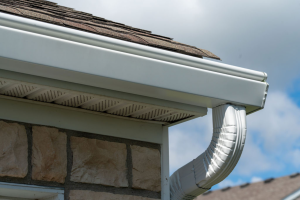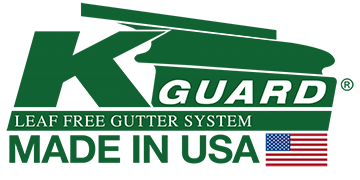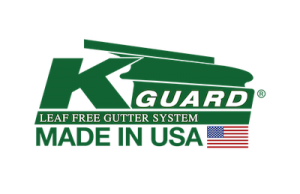A property’s gutter system is one of the most taken-for-granted exterior components. Property owners expect the system to capture roof runoff water effectively, with gutters taking said water to the downspouts where it can be safely discharged away from the foundation. A properly functioning gutter system helps properties avoid foundation issues and potential water intrusion. However, an improperly functioning system poses some significant threats.
runoff water effectively, with gutters taking said water to the downspouts where it can be safely discharged away from the foundation. A properly functioning gutter system helps properties avoid foundation issues and potential water intrusion. However, an improperly functioning system poses some significant threats.
In this post, we’re going to take a look at two key components behind any well functioning gutter system: gutters and downspouts. We’ll discuss the key differences between these two components and also share information on how to properly maintain each so that your gutter system can continue to operate efficiently and effectively. Here’s a closer look at what you need to know:
Gutters vs. Downspouts: What’s the Difference?
Both gutters and downspouts are both a part of your property’s gutter system, which is designed to discharge snowmelt and rainwater runoff safely away from your home. However, gutters and downspouts are different in the functions that they serve. In this section, we’ll take a closer look at the different – yet equally important – roles that each of these components serve.
Gutters
Gutters run horizontally along the entirety of the roof edge and capture water runoff as it leaves the roof line. Gutters then work to direct this water to the downspouts, where it is discharged away from the home. However, gutters must be installed properly in order for them to work effectively. For instance, they must be pitched so that once water enters, it can travel to the downspout. Most recommend a gutter pitch of about a quarter inch for every 10 feet worth of gutter length, making proper installation important. Gutters typically install right into the fascia of the property.
Without gutters, water would run off the roof of your property and pool up around the foundation. This could lead to a bevy of problems, such as foundation erosion, and water intrusion and mold growth.
Downspouts
Downspouts are components that run vertically. They connect at the end of the gutter and work to discharge water safely away from the property and its foundation. Downspouts have elbows to help disperse the water and are typically installed into the likes of porch columns and exterior siding or brick to keep them stable and secure as water flows down them.
It’s typically suggested that downspouts are installed in a manner so that water is dispersed at least 10 feet away from the property foundation to avoid water intrusion or foundation erosion issues. The exception is if the land is graded away from the property where the downspouts are installed. In some cases, downspout extenders may need to be installed so that water can safely drain away from the property.
Bottom line: Gutters capture the water and send it to the downspouts. The downspouts finish the process by discharging water away from the property.
Gutter and Downspout Maintenance
Now that we’ve gone over some of the key differences between gutters and downspouts, it’s time to focus on one key similarity between the two components: They both need to be properly maintained in order to ensure that your gutter system is working effectively and efficiently. And there are some key considerations and tips that you want to keep in mind when it comes to gutter and downspout maintenance. Here’s a look at what you need to know when it comes to proper maintenance of gutters and downspouts:
They should be cleaned out at least twice a year
It’s usually best practice to clean out your gutters and downspouts in the early spring and then again in the late fall. Remove any leaves, twigs and other debris to ensure that water can properly travel through your gutters to your downspouts and then discharge appropriately from the downspout. When you’re cleaning downspouts, pay special attention to the elbow joints, as these are the areas where debris tends to accumulate and clogs tend to occur.
If gutters and downspouts clog, it means that the system can’t discharge water appropriately. This could result in overflowing gutters and possible damage to your property. It means that ice dams are more likely to form during the winter months. And it means that your gutter system could suffer damage as well, impacting its ability to perform even when it is properly cleaned.
Gutter guards can help
Don’t like cleaning out your gutters or paying someone to do it for you? Gutter guards can help. These components install over gutters and help prevent the likes of leaves, twigs and other debris from entering your gutter system, thereby preventing clogs and obstructions while water is able to still freely flow through the gutters and downspouts. In addition to reducing maintenance, gutter guards can also increase the value of your home and make it more attractive for potential buyers should it hit the market.
Check for leaks, joint problems
The most problematic parts of a gutter system are where joints connect the different components. These areas can come loose over time and separate, resulting in leaks. There are a few tried and true ways to resolve joint problems. The first way is via preventative maintenance and ensuring that your gutter system is free of clogs. This is because joint areas of gutters often separate due to the weight of the water when clogs are present in the system. And two, you can visually inspect joint areas for problems. Just grab an umbrella the next time it rains, step outside and take a walk around your home to ensure the system is operating efficiently and effectively. Take note of any leaks and ensure the proper repairs are made before the next expected rainfall.
Contact K-Guard
For more information on the differences between gutters and downspouts, and to learn more about gutter guards and other ways to maintain your gutter system, contact K-Guard or one of our distributors today.

